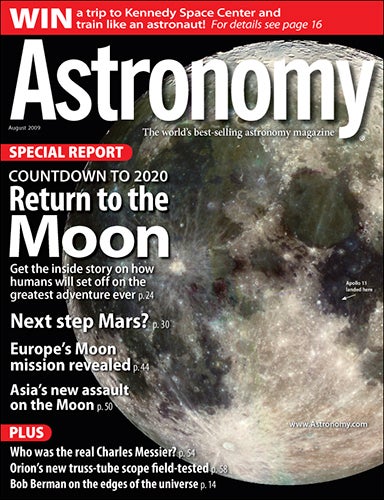
WAUKESHA, Wis. — On December 14, 1972, astronaut Gene Cernan lifted his foot from the lunar surface, ending the first wave of human exploration of the Moon with the promise, “We shall return.” Now, more than a generation later, NASA is making plans for a next round of exploration.
Astronomy‘s August issue investigates current unmanned missions and future plans for the Moon in a special report. Articles explore NASA’s new lunar program, proposals for subsequent manned Mars missions, Europe’s recent Moon mission, and China and Japan’s lunar expeditions. This special issue will be available on newsstands June 30.
“How we’ll return to the Moon”
When NASA’s manned lunar missions commence as early as 2020, the systems that will transport astronauts to the Moon will bear a superficial resemblance to the tried-and-true Apollo hardware. In reality, these similarities only obscure the vast improvements the new program will contain, dubbed “Apollo on steroids.” In “How we’ll return to the Moon,” author James Oberg, a former NASA space engineer, summarizes the updated technology of the new lunar lander and command module and explains how this new equipment will send humans back to Earth’s only natural satellite — and bring them home. The article includes stunning digital artwork of each phase of lunar exploration, as well as a detailed illustration that explains each step of the journey to the Moon.
“Next step Mars?”
We’ve already managed to put astronauts on the Moon, but landing humans on Mars will pose new challenges and great dangers. As NASA plans for a “Moon first, then Mars” strategy, others believe manned missions to the Red Planet should be the focus now and not just in the distant future. In “Next step Mars?” Associate Editor Daniel Pendick explores current proposals for getting astronauts to the Red Planet and analyzes one of the biggest challenges such proposals have to overcome — landing heavy payloads in one piece.
Recent pioneering lunar missions
As the world prepares for future manned missions to the Moon, individual agencies have sent their first probes to our satellite, including the European Space Agency (ESA), the Japan Aerospace Exploration Agency (JAXA), and the Chinese National Space Administration (CNSA). In “What Europe’s Moon mission revealed,” SMART-1 Lead Project Scientist Bernard H. Foing explains how ESA’s lunar probe served as a steppingstone for future solar system exploration. And Senior Editor Michael E. Bakich summarizes the accomplishments of JAXA’s and CNSA’s first-ever lunar missions in “Asia’s new assault on the Moon.”
Also in the August 2009 Astronomy
- “Who was the real Charles Messier?” — His catalog of deep-sky objects may be world famous, but most people don’t know much about the man behind it.
- “Orion’s truss-tube scope offers powers and portability” — Contributing Editor Phil Harrington reviews Orion’s SkyQuest XX12 reflector.
- “The Sky This Month” — Exclusive pullout star charts will guide you through August’s night sky.
- The August issue of Astronomy also includes Astro News, Astro Confidential, Bob Berman’s Strange Universe, Glenn Chaple’s Observing Basics, David Levy’s Evening Stars, Stephen James O’Meara’s Secret Sky, Ask Astro, New Products, Telescope Insider, The Cosmic Grid, and Reader Gallery.









